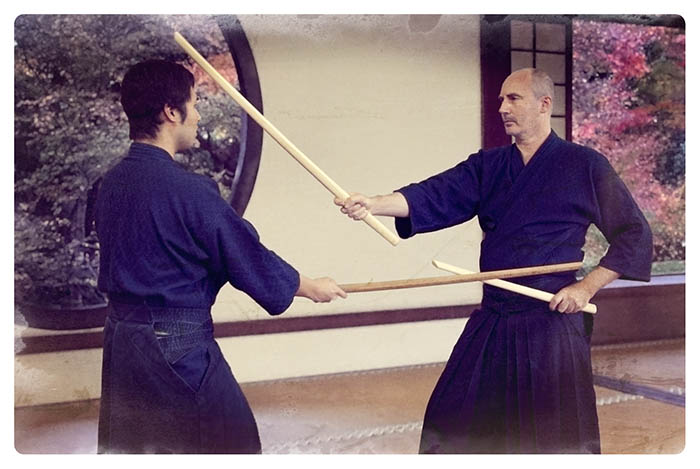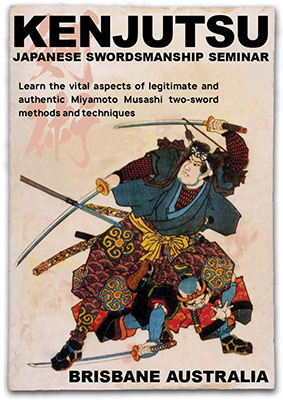The style or way of using two swords simultaneously in Japanese swordmanship is commonly referred to as Nitō-ryū (二刀流 two-sword style). Of course, Shinmen Musashi-no-Kami Fujiwara no Genshin – more commonly known as Miyamoto Musashi (宮本武蔵) - was an acclaimed exponent of Nitō-ryū and is revered as one of Japan's greatest Kensei (sword saints). Musashi founded a school of strategy called Niten Ichi-ryū; which he also referred to as Nitō Ichi-ryū within his seminal works of Hyōhō Sanjugo Kajo (35 articles on Strategy) and Gorin-no-Sho (Book of Five Rings).

The Nitōjuku (二刀塾 two-sword private school) has been established to offer Japanese sword training with a primary focus on the simultaneous use of two swords.
Nitōjuku's senior instructor, Greg Clarke, was a monkasei (direct personal student) of Iwami Toshio sōke, the 11th head of Musashi’s Seitō Santō-ha Hyōhō Niten Ichi-ryū, as well as a monkasei of the late Ishida Hiroaki shihan, a menkyo-kaiden in Noda-ha Niten Ichi-ryū and menkyo in Musashi's Owari Enmei-ryū Kenjutsu (Shunpūkan Dōjō).
The above-mentioned koryū ryūha (classical schools) have real connections to Musashi's teachings, and consist of extant Nitō waza (two-sword techniques), kata (forms) and kuden (oral transmissions).
Genshin Nitō Ichi-ryū Kenjutsu (玄心二刀一流剣術) is a codified distillation of authentic koryū kenjutsu training over twenty-plus years, drawing on legitimate Nitō-ryū, in both waza (techniques) and corresponding riai (underlying rationale), across the direct mentorship and transmission from two genuine Japanese shihan (master-teachers). As such, it could be considered a contemporary traditional art of Musashi-related Nitō-ryū, beyond what can be presently studied within just a single line of koryū transmission connected to Musashi.

Genshin Nitō Ichi-ryū Kenjutsu consists of three practice sets within the curriculum - Kiso (基礎 foundation), Tenkai (展開 expansion), and Tōgō (統合 integration) - each with its own character and purpose. The paramount and key set, Tōgō, encompasses the same five koryū kata or old-style forms as the Nitō Seihō of Musashi's Niten Ichi-ryū. These particular patterns contain the essential Gohō-no-Tachimichi and are fundamentally the representative outlines of Miyamoto Musashi's Hyōhō-no-Hyōshi.
Furthermore, although not kata per se but kihon sotai dosa (fundamental paired movements), the inital Kiso and Tenkai sets deliver crucial intrinsic Nitō waza and riai that, in the end, instill additional principles and transmission line variations (henka). These may be integrated within and throughout the Tōgō to provide a more comprehensive and profound understanding of Musashi's Nitō Ichi-ryū Kenjutsu. Realistically, in the past, there would have been greater depth to Musashi's Nitō principles and techniques than what are now found in any single classical (koryū) school of the various present-day transmissions within Japan.
| Kiso 基礎 / Tenkai 展開 |
Tōgō 統合 |
| |
|
| Uken 右剣 |
Chūdan 中段 |
| Saken 左剣 |
Jōdan 上段 |
| Uchikomi 打込 |
Gedan 下段 |
| Yokouchi 横打 |
Hidari Wakigamae 左脇構 |
| Ashiuchi 足打 |
Migi Wakigamae 右脇構 |
| Uchigaeshi 打返 |
|
| Noriuchi 乗打 |
|
| Kotetsuke 小手附 |
|
| Hidariuke 左受 |
|
| Migiuke 右受 |
|
| Uchidome 打留 |
|
| Tsukidome 突留 |
|
Primarily, regular training involves the in-depth study and immersion in the practice sets, through a koryū-based learning process of 'Shu-Ha-Ri', under the direct tutelage of the senior instructor. The practice is structured and systematic, with the kata of the Tōgō set still retaining their koryū kenjutsu pedagogical methods originally aimed to enable the exponent to successfully use dual swords in mortal combat.
Further, in the final section within Gorin-no-Sho's Wind Scroll epilogue, Musashi concludes by stating his swordsmanship has no distinction of entrance and interior teachings, and no ultimate (secret) guard/stances. And, most importantly, elucidates the essence of his Hyōhō/Heihō (combat laws/methods: [kenjutsu]) is merely that the mind comes to understand the swords' efficacy/benefit (徳: [太刀の効能]) [1].
Although frequently misunderstood, it's the mastery of essentials and simplicity, rather than the sophisticated and complexity, that is the ultimate technical attainment within Kenjutsu. Even 400 years ago, Musashi, through his teachings, sought to edify proponents of Japanese swordsmanship that the true path ran counter to a 'complexity bias'.

Kenjutsu is suitable for a person without disability, regardless of gender or previous martial arts experience and there's a minimum age requirement of 18. Training should not be undertaken lightly, it requires a dedicated long-term commitment and a serious attitude towards practice to potentially master Nitō Ichi-ryū.

As of 2024, Greg has elected to discontinue the Japanese Swordsmanship group classes that had been open to the public; primarily to enable shugyō into deeper keiko rather than a focus on teaching. However, he continues to teach privately in a limited group manner to select existing students, and through special guest or visitor invitation only.
Visit our Facebook Page
|

